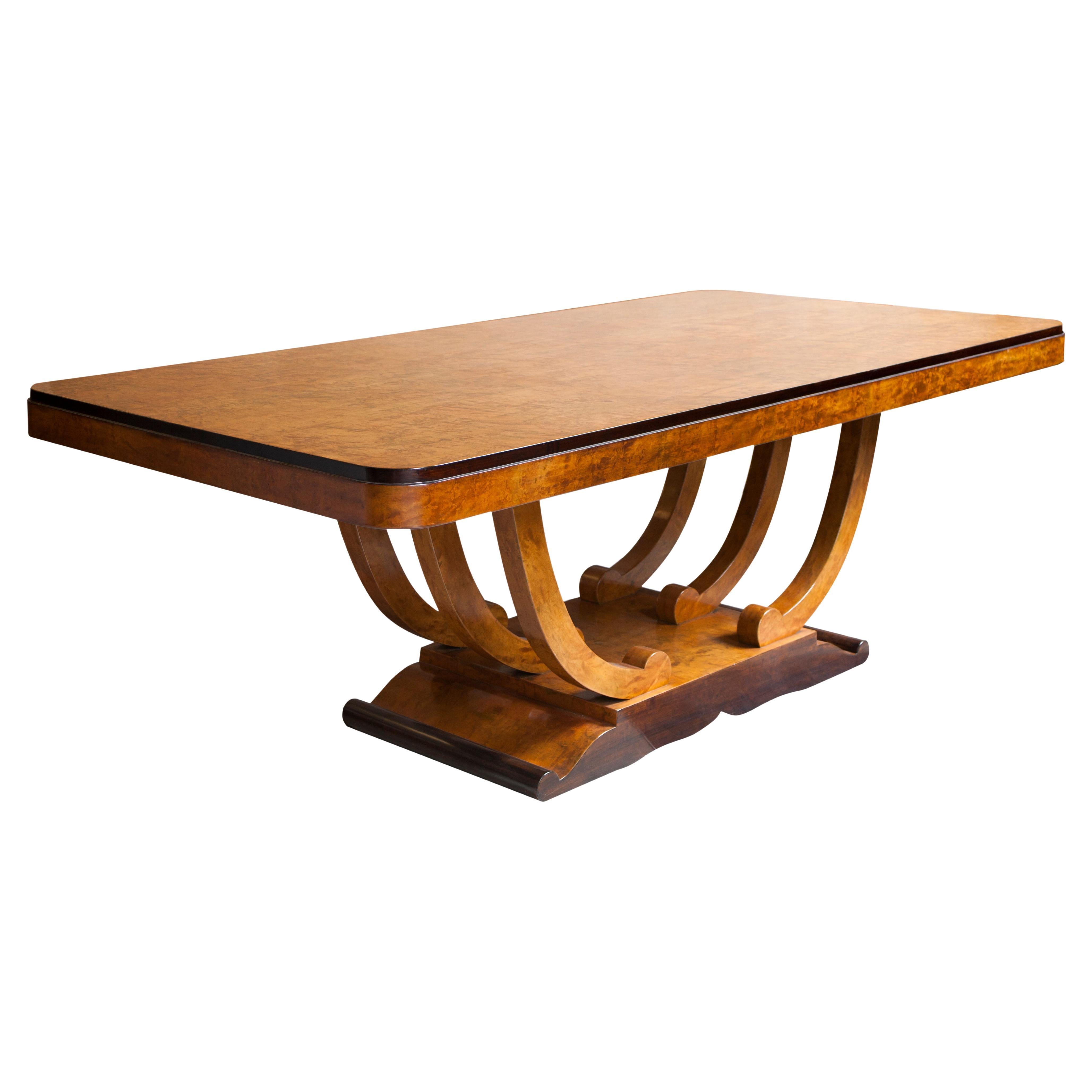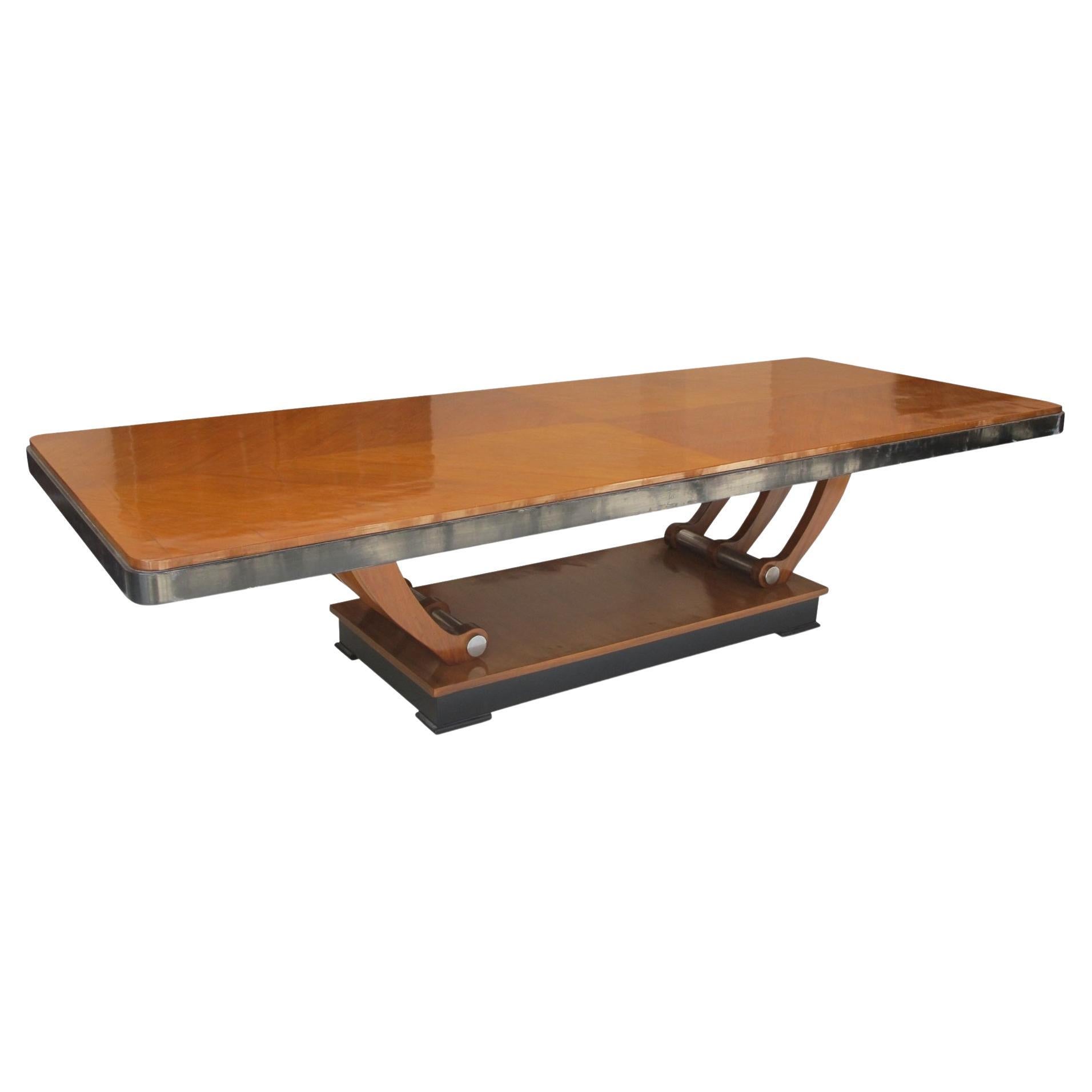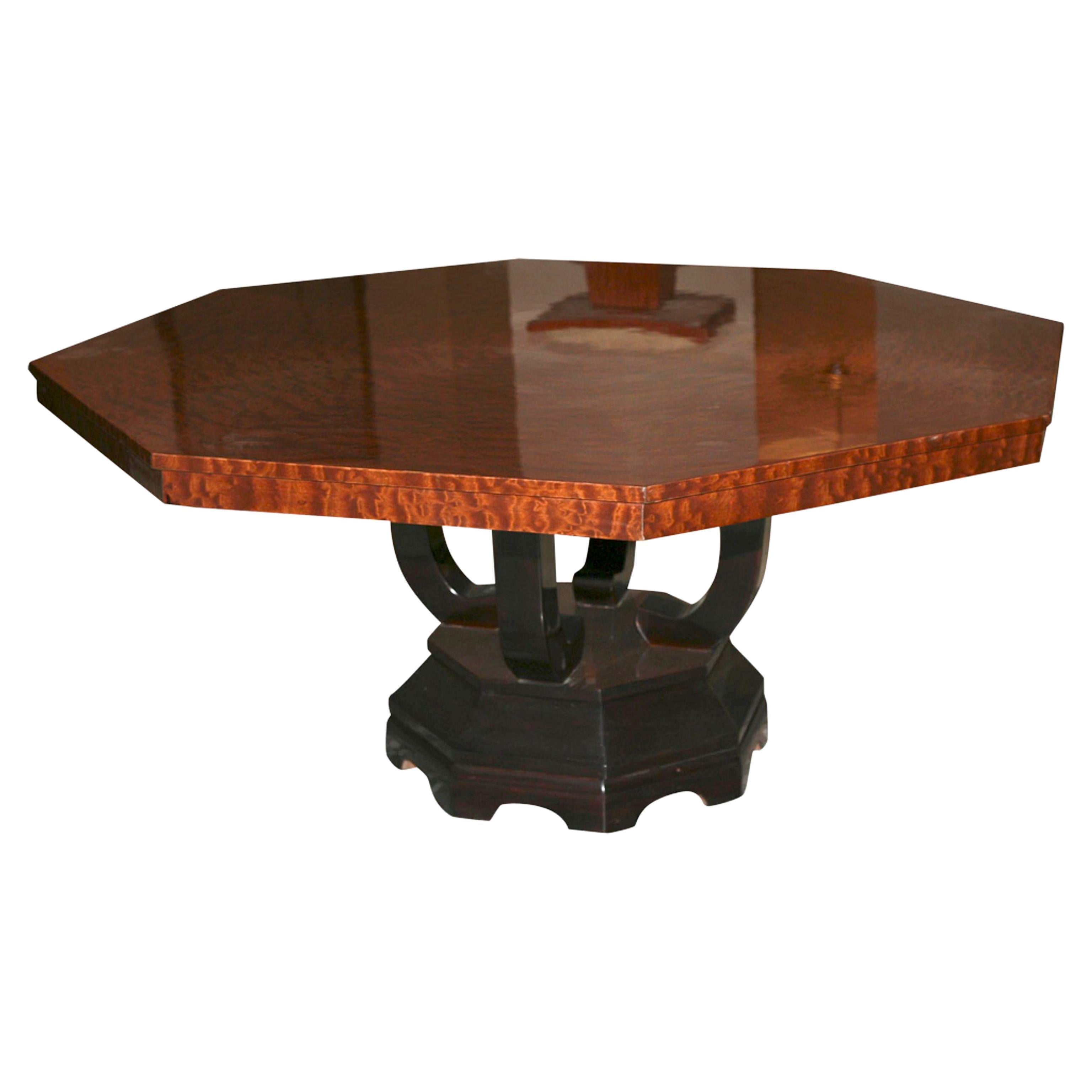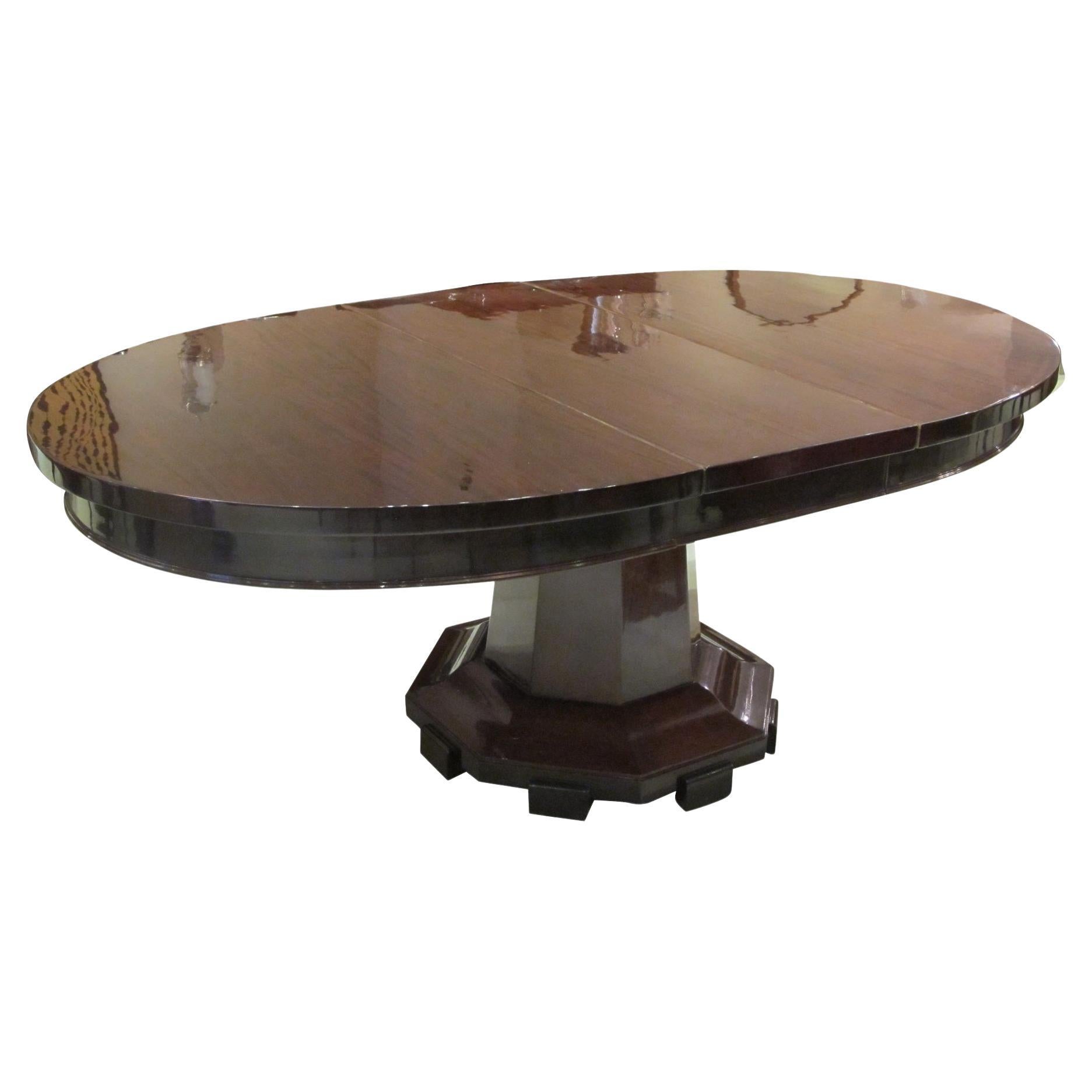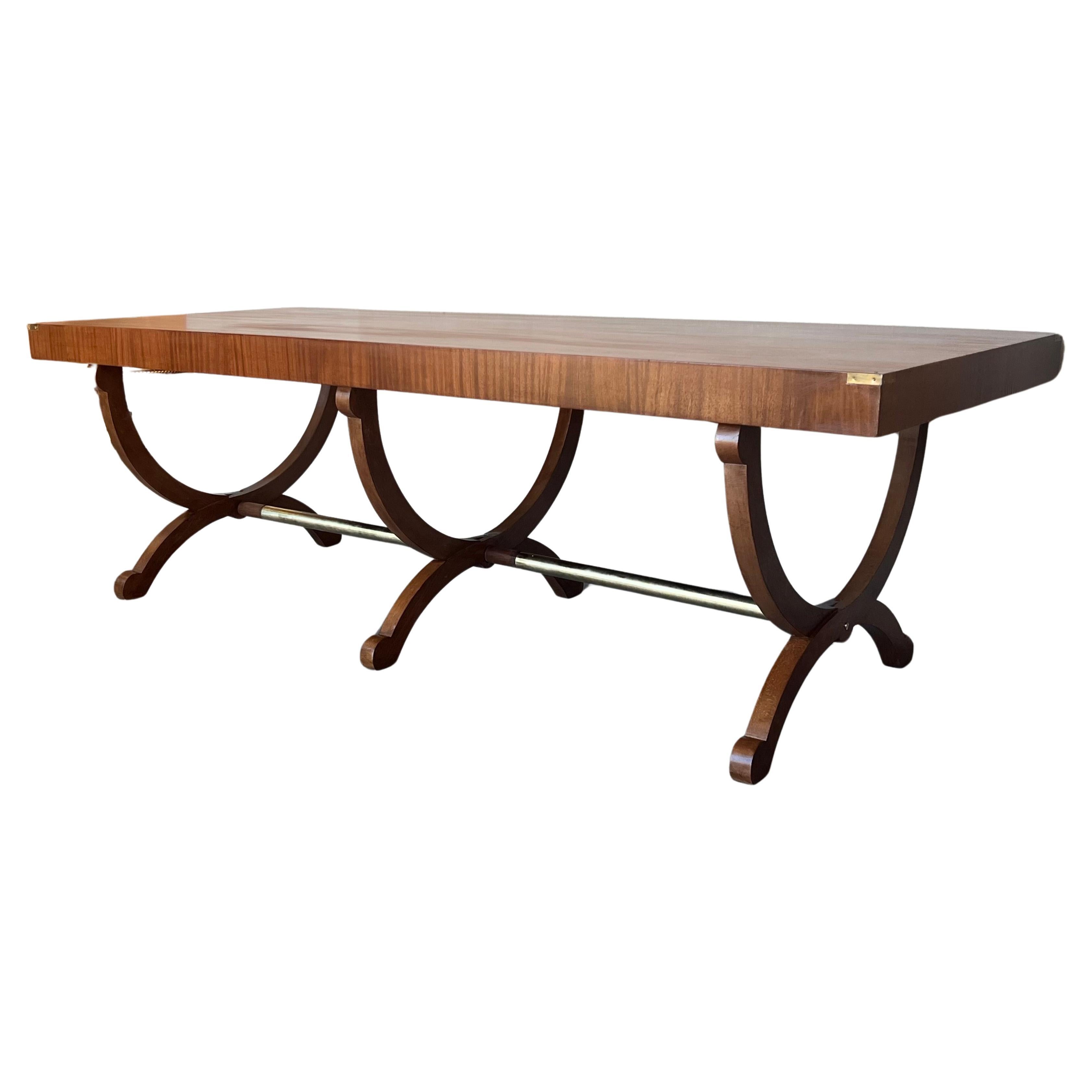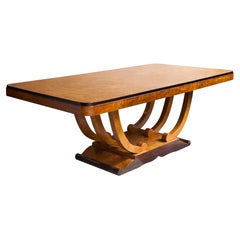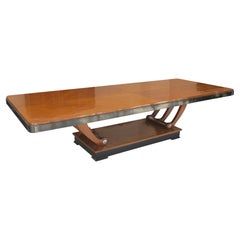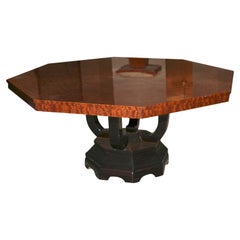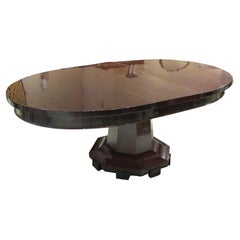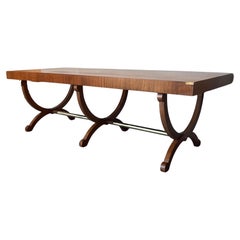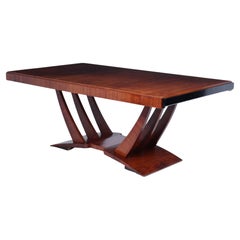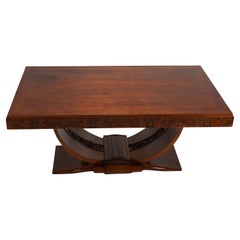Objekte ähnlich wie Esszimmertisch, Stil: Art déco, „10 Personen“, Jahr: 1920
Video wird geladen …
Möchten Sie mehr Bilder oder Videos?
Zusätzliche Bilder oder Videos von dem*der Anbieter*in anfordern
1 von 22
Esszimmertisch, Stil: Art déco, „10 Personen“, Jahr: 1920
20.679,46 €
Versand
Angebot wird abgerufen …Das Versprechen von 1stDibs:
Authentizitätsgarantie,
Geld-Zurück-Garantie,
Stornierung innerhalb von 24 Stunden
Angaben zum Objekt
Dining table Art Deco (Does not include glass)
Year: 1920
Country: French
Wood
Finish: polyurethanic lacquer
It is an elegant and sophisticated dining table.
You want to live in the golden years, this is the dining table that your project needs.
We have specialized in the sale of Art Deco and Art Nouveau styles since 1982.
Pushing the button that reads 'View All From Seller'. And you can see more objects to the style for sale.
Why are there so many antiques in Argentina?
In the 1880 – 1940 there was a grate wave of immigration encouraged by the periods of war that were taking place.
1st World War took place between 1914 and 1918
2nd World War took place between 1939 and 1945
The immigrants options were New York or Buenos Aires. Tickets were cheap and in Buenos Aires they were welcomed with open arms, as it was a country where everything was still to be done.
Argentina was the country of new opportunities, labour was needed and religious freedom was assured, in many cases the of the family travel first until they were settled and then the rest of the family members join them.
In the immigrant museum “Ellis Island Immigrant Building” in New York you can se the promotional posters of the boats that would take them to a new life.
Between the years 1895 and 1896, Argentina had the highest DGP (gross domestic product) per capita in the world according to the Maddison Historical Statistics index, this situation arose due to the large amount of food being exported to European countries, which were at war.
The Argentinean ships left the port of Buenos Aires with food, but they returned with furniture, clothes and construction elements, (it´s common to see this the old buildings of the historic neighbourhood of San Telmo, the beams with the inscription “Made in England)”, as well as many markets that were built in Buenos Aires, such us the San Telmo Market, whose structure was brought by ship and afterwards assembled in 900 Defensa Street.
With the great influence of European immigrants living in the country, the children of the upper classes travelled to study in France, resulting in the inauguration of “La Maison Argentinienne”, on 27th of June 1928, in the international city of Paris, which hosted many Argentinians that were studying in Frace.
It´s the fourth house to be built after France, Canada and Belgium, being the first Spanish-speaking one. Still in place today (17 Bd Jourdan, 75014, Paris, France). Many of the children of these wealthy families who attended international art exhibitions, museums and art courses abroad, took a keen interest in the European style. This is why Buenos Aires was at the time referred as “The Paris of South America”.
Between the years 1890 and 1920 more than a hundred Palaces were built on Alvear Avenue the most exclusive avenue in Buenos Aires. Today some of these palaces have been transformed into museums, hotels and embassies.
In the year 1936, the Kavanagh building was inaugurated, it was the tallest reinforced concrete building in South America.
During 1994 the American Society of Civil Engineers distinguished it as an “international engineering milestone”, and it´s now considered a World Heritage of Modern Architecture.
At the time was common to hire foreign architects such as Le Corbusier, who visited Buenos Aires/Argentina in 1929 and in 1948 he drew up the blueprints for a house built in La Plata City (which was declared a World Heritage Site).
In 1947, the Hungarian architect Marcelo Breuer designed “Parador Ariston” in the seaside city of Mar del Plata. After an Argentinean student at Harvard University convinced him to come to Argentina. He worked on an urban development project in the Casa Amarilla, area of La Boca.
The Ukrainian architect, Vladimiro Acosta, arrives in Argentina in 1928 and worked as an architect until que moved to Brazil.
Antonio Bonet, a Spanish architect who worked with Le Corbusier in Paris, arrives in Argentina in 1937, where he carried out several architectural works and in 1938 designs the well-known BFK chair.
Andres Kálnay, of Hungarian origin, made around 120 architectural masterpieces, among which the former Munich brewery stands out, he even made the furniture’s design.
The German architect, Walter Gropius, director of the Bauhaus, lived in Argentina, where he wrote articles for “Sur” magazine and founded in Buenos Aires, an architectural firm with Franz Möller, who was also an architect, where he built two houses.
At the same time several famous designers decided to immigrate to Argentina, among them we can find the well-known French designer, Jean-Michel Frank, who arrived in the country in 1940 and also worked for the Rockefeller family.
Special pieces were made, which were sold exclusively in the country, such as the well-known German company “WMF”, who sold their products by catalogue, which were chosen by the ladies of high society in the list of wedding gifts, as well as the pieces designed by Christofle.
The Swiss sculptor Alberto Giacometti, made special pieces for Argentinean mansions.
In 1904 the first Jansen branch outside Paris was established in Buenos Aires, as the Argentinean clientele demanded a large amount of furniture, from the end of the 19th century to the mid-20th century.
In 1970, the brand Rigolleau Argentina made pieces authorised by Lalique.
The brands Maple and Thompson also set up shop in the country.
The French plastic artist, Marcel Duchamp moved to Argentina in 1918-1919.
Glass signed Gallé, Charder, Leverre, Schneider, Muller and other French firms. They were bought in flower shops and were given to ladies with beautiful floral arrangements.
Some furniture manufacturers travelled to international fairs and bough the patterns to produce the furniture in Argentina, such as the furniture firm Englander and Bonta, who bought the patterns ins Italy.
It is worth mentioning that in Argentina we have the largest community of Italians outside of Italy, as it is estimated that 70 percent of the inhabitants have at least one Italian descendant, followed by Spanish immigrants.
The most Important furniture stores in Argentina:
Comte is founded in 1934 (under the direct management of Jean Michel Frank in 1940).
Nordiska (Swedish company established in 1934).
Churba in 1960, a company that brought foreign designers to present their furniture in the country:
Denmark: (Arne Jacobsen, Finn Juhl, Bender Madsen, Ejner Larsen, Poul Kjaerholm, Hans Wegner)
Sweden: (Hans Agne Jakobsson, Gustavsberg)
United States: (Herman Miller)
Finland: (Lisa Johansson, Folke Arstrom, Tapio Wirkkala, Alvar Aalto, Timo Sarpaneva)
Swedish Factory: (Orrefors)
Italy: (Littala, Vico Magistretti, Emma Gismondi, Gae Aulenti, Angelo Mangiarotti, Elio Martinelli, Gianna Celada, Angelo Mangiarotti, Mario Bellini, Carlo Scarpa)
Finland: (Olivia Toikka)
Plata Lappas (Lappas Silver): a goldsmith shop founded in 1887 in Argentina by Alcibiades Lappas of Greek origin.
In 2019, in Argentina took place “the Art Deco world congress”, in which we participated as hosts invited by Geo Darder, founder of the Copperbridge – Foundation, in which prominent people from all over the world attended to learn about Art Deco in Argentina.
Argentina currently has more than 100 Art Deco buildings and another 90 Art Nouveau buildings throughout the city of Buenos Aires.
Argentina is a country that has not been involved in many wars, which is why it has been a refuge for works of art and antiques from different periods of time, unlike European countries. That is way many collectors, museums and antique dealers from all over the world visit it, you should not miss the opportunity to visit this great country.
Laura Guevara Kjuder, architect.
- Maße:Höhe: 79 cm (31,11 in)Breite: 240 cm (94,49 in)Tiefe: 111,5 cm (43,9 in)
- Stil:Art déco (Aus dem Zeitalter)
- Materialien und Methoden:
- Herkunftsort:
- Zeitalter:
- Herstellungsjahr:1920
- Zustand:Abnutzung dem Alter und der Nutzung entsprechend.
- Anbieterstandort:Ciudad Autónoma Buenos Aires, AR
- Referenznummer:Anbieter*in: F-TO-3241stDibs: LU6785230634522
Anbieterinformationen
5,0
Geprüfte*r Anbieter*in
Jede*r Anbieter*in erfüllt strenge Standards bezüglich Echtheit und Zuverlässigkeit
Gründungsjahr 1982
1stDibs-Anbieter*in seit 2022
37 Verkäufe auf 1stDibs
Typische Antwortzeit: <1 Stunde
- VersandAngebot wird abgerufen …Versand von: Ciudad Autónoma Buenos Aires, Argentinien
- Rückgabebedingungen
Einige Inhalte dieser Seite wurden automatisch übersetzt. Daher kann 1stDibs nicht die Richtigkeit der Übersetzungen garantieren. Englisch ist die Standardsprache dieser Website.
Authentizitätsgarantie
Im unwahrscheinlichen Fall eines Problems mit der Echtheit eines Objekts kontaktieren Sie uns bitte innerhalb von 1 Jahr für eine volle Rückerstattung. DetailsGeld-Zurück-Garantie
Wenn Ihr Objekt nicht der Beschreibung entspricht, beim Transport beschädigt wurde oder nicht ankommt, kontaktieren Sie uns bitte innerhalb von 7 Tagen für eine vollständige Rückerstattung. DetailsStornierung innerhalb von 24 Stunden
Sie können Ihren Kauf jederzeit innerhalb von 24 Stunden stornieren, ohne jegliche Gründe dafür angeben zu müssen.Geprüfte Anbieter*innen
Unsere Anbieter*innen unterliegen strengen Dienstleistungs- und Qualitätsstandards, wodurch wir die Seriosität unserer Angebote gewährleisten können.Preisgarantie
Wenn Sie feststellen, dass ein*e Anbieter*in dasselbe Objekt anderswo zu einem niedrigeren Preis anbietet, werden wir den Preis entsprechend anpassen.Zuverlässige weltweite Lieferung
Unsere erstklassigen Versandunternehmen bieten spezielle Versandoptionen weltweit, einschließlich individueller Lieferung.Mehr von diesem*dieser Anbieter*in
Alle anzeigenEsszimmertisch, Stil: Art Deco, 1920, 8 Personen, Material: Holz
Esstisch Art Deco
Jahr: 1920
Land: Französisch
Holz
Oberfläche: Polyurethan-Lack
Er ist ein eleganter und anspruchsvoller Esstisch.
Sie wollen in den goldenen Jahren leben, ist die...
Kategorie
Vintage, 1920er, Französisch, Art déco, Esstische
Materialien
Holz
Esszimmertisch, Stil, Art déco, 1920, 12 Personen, Material, Holz
Esstisch Art Deco
Es wird neu poliert geliefert
Jahr: 1920
Land: Französisch
Holz
Oberfläche: Polyurethan-Lack
Er ist ein eleganter und anspruchsvoller Esstisch.
Sie wollen in den ...
Kategorie
Vintage, 1920er, Französisch, Art déco, Esstische
Materialien
Holz
Tisch, Stil, Art déco, „8 Personen“, Jahr, 1920
Esstisch Art Deco
Jahr: 1920
Land: Französisch
Holz
Oberfläche: Polyurethan-Lack
Er ist ein eleganter und anspruchsvoller Esstisch.
Sie wollen in den goldenen Jahren leben, ist die...
Kategorie
Vintage, 1920er, Französisch, Art déco, Esstische
Materialien
Holz
Esszimmertisch, Stil: Art déco, Frankreich 1920, '8 Personen', Material: Holz
Esstisch Art Deco
Jahr: 1920
Land: Französisch
Holz
Oberfläche: Polyurethan-Lack
Er ist ein eleganter und anspruchsvoller Esstisch.
Sie wollen in den goldenen Jahren leben, ist die...
Kategorie
Vintage, 1920er, Französisch, Art déco, Esstische
Materialien
Holz
Esszimmertisch im Art déco-Stil mit zwei Verlängerungen, 1920 '12 Personen'
Esstisch Art Deco mit zwei Verlängerungsplatten
Es wird vor der Auslieferung neu poliert
Jahr: 1920
Land: Französisch
Holz
Er ist ein eleganter und anspruchsvoller Esstisch.
Sie wo...
Kategorie
Vintage, 1920er, Französisch, Art déco, Esstische
Materialien
Holz
Art déco-Esstisch „8 Personen“, 1920, Material: Holz Französisch
Esstisch Art Deco.
Jahr 1920
Land: Französisch
Holz
Oberfläche: Polyurethan-Lack
Er ist ein eleganter und anspruchsvoller Esstisch.
Sie wollen in den goldenen Jahren leben, ist die...
Kategorie
Vintage, 1920er, Französisch, Art déco, Esstische
Materialien
Holz
Das könnte Ihnen auch gefallen
Großer Esstisch oder Flurtisch im Art déco-Stil von 1930
Dieser Tisch wurde um 1930 in Frankreich hergestellt und ist ein vielseitiger Tisch, der als gelegentlicher Esstisch, Flurtisch oder Schreibtisch verwendet werden kann. Die Platte w...
Kategorie
Frühes 20. Jahrhundert, Französisch, Art déco, Esstische
Materialien
Metall
Vintage Art Deco-Esstisch
Ein atemberaubender Mahagoni-Tisch im Art-Deco-Stil, der Ihre Gäste über Jahre hinweg beeindrucken wird. Eine große Tischplatte bietet viel Platz für alles, von Dinnerpartys bis zu V...
Kategorie
Mitte des 20. Jahrhunderts, Art déco, Esstische
Materialien
Bugholz, Mahagoni
1.868 € Angebotspreis
32 % Rabatt
Original französischer Art Déco Esstisch
Ein spektakulärer originaler französischer Art Deco Esstisch aus der Zeit um 1930, der exotische MATERIALIEN mit einer kühnen architektonischen Form verbindet. Die Tischplatte ist au...
Kategorie
Vintage, 1930er, Französisch, Art déco, Esstische
Materialien
Rosenholz
Außergewöhnlicher Art Deco Esstisch
Dieser außergewöhnliche Art-Déco-Esstisch aus reichem Nussbaumholz ist ein hervorragendes Beispiel für das Design und die Handwerkskunst dieser Zeit. Der Tisch lässt sich mit zwei fe...
Kategorie
Mitte des 20. Jahrhunderts, Französisch, Art déco, Esstische
Materialien
Walnuss
Esstisch im Art-déco-Stil aus der Mitte des 20. Jahrhunderts
Auf einem Nachlassverkauf in Buenos Aires erworben und aus Argentinien importiert, handelt es sich um einen aus Holz gefertigten Tisch im Art-déco-Stil aus der Mitte des 20. Jahrhund...
Kategorie
Mitte des 20. Jahrhunderts, Französisch, Art déco, Esstische
Materialien
Holz
Französischer Mahagoni-Ess-/Bibliothekstisch im Art déco-Stil
Ein großartiger Tisch, der mit seinem schlichten Design und seiner raffinierten Ausführung an die Dekoepoche erinnert. Der geschwungene Sockel bietet zeitlose Eleganz, die durch das ...
Kategorie
Frühes 20. Jahrhundert, Französisch, Art déco, Esstische
Materialien
Messing
